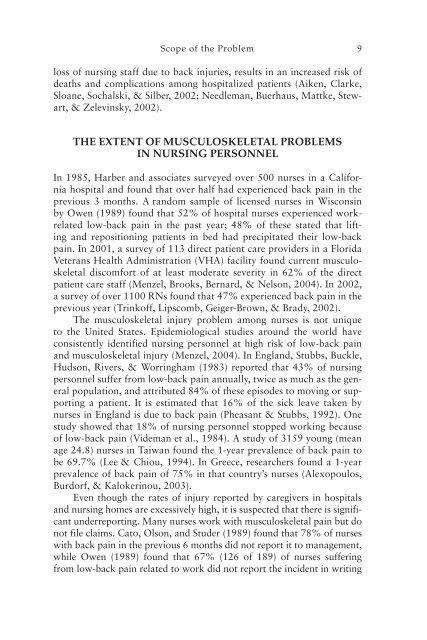Safe Patient Handling and Movement - Springer Publishing Company
Safe Patient Handling and Movement - Springer Publishing Company
Safe Patient Handling and Movement - Springer Publishing Company
You also want an ePaper? Increase the reach of your titles
YUMPU automatically turns print PDFs into web optimized ePapers that Google loves.
Scope of the Problem 9<br />
loss of nursing staff due to back injuries, results in an increased risk of<br />
deaths <strong>and</strong> complications among hospitalized patients (Aiken, Clarke,<br />
Sloane, Sochalski, & Silber, 2002; Needleman, Buerhaus, Mattke, Stewart,<br />
& Zelevinsky, 2002).<br />
THE EXTENT OF MUSCULOSKELETAL PROBLEMS<br />
IN NURSING PERSONNEL<br />
In 1985, Harber <strong>and</strong> associates surveyed over 500 nurses in a California<br />
hospital <strong>and</strong> found that over half had experienced back pain in the<br />
previous 3 months. A r<strong>and</strong>om sample of licensed nurses in Wisconsin<br />
by Owen (1989) found that 52% of hospital nurses experienced work-<br />
related low-back pain in the past year; 48% of these stated that lifting<br />
<strong>and</strong> repositioning patients in bed had precipitated their low-back<br />
pain. In 2001, a survey of 113 direct patient care providers in a Florida<br />
Veterans Health Administration (VHA) facility found current musculoskeletal<br />
discomfort of at least moderate severity in 62% of the direct<br />
patient care staff (Menzel, Brooks, Bernard, & Nelson, 2004). In 2002,<br />
a survey of over 1100 RNs found that 47% experienced back pain in the<br />
previous year (Trinkoff, Lipscomb, Geiger-Brown, & Brady, 2002).<br />
The musculoskeletal injury problem among nurses is not unique<br />
to the United States. Epidemiological studies around the world have<br />
consistently identified nursing personnel at high risk of low-back pain<br />
<strong>and</strong> musculoskeletal injury (Menzel, 2004). In Engl<strong>and</strong>, Stubbs, Buckle,<br />
Hudson, Rivers, & Worringham (1983) reported that 43% of nursing<br />
personnel suffer from low-back pain annually, twice as much as the general<br />
population, <strong>and</strong> attributed 84% of these episodes to moving or supporting<br />
a patient. It is estimated that 16% of the sick leave taken by<br />
nurses in Engl<strong>and</strong> is due to back pain (Pheasant & Stubbs, 1992). One<br />
study showed that 18% of nursing personnel stopped working because<br />
of low-back pain (Videman et al., 1984). A study of 3159 young (mean<br />
age 24.8) nurses in Taiwan found the 1-year prevalence of back pain to<br />
be 69.7% (Lee & Chiou, 1994). In Greece, researchers found a 1-year<br />
prevalence of back pain of 75% in that country’s nurses (Alexopoulos,<br />
Burdorf, & Kalokerinou, 2003).<br />
Even though the rates of injury reported by caregivers in hospitals<br />
<strong>and</strong> nursing homes are excessively high, it is suspected that there is significant<br />
underreporting. Many nurses work with musculoskeletal pain but do<br />
not file claims. Cato, Olson, <strong>and</strong> Studer (1989) found that 78% of nurses<br />
with back pain in the previous 6 months did not report it to management,<br />
while Owen (1989) found that 67% (126 of 189) of nurses suffering<br />
from low-back pain related to work did not report the incident in writing<br />
14108_C01pg001-026.indd 9 11/11/05 1:24:43 PM

















